
NOTCam Darks - revisited Apr 2011NOTCam darksDark integrations are obtained with the commands dark, mdark and dframe. The latter was introduced to NOTCam BIAS in 2002 to allow for dark current measurements using the ramp-sampling readout mode.For both readout modes the measured dark current is non-linear, variable and higher than the specs from Rockwell/Teledyne (< 0.1 e-/s/pix). The graph below shows a typical result obtained from the Detector Quality Control (QC) for the reset-read-read mode. When integrating without opening the shutter, we measure intensity levels of ~ 1 ADU/s/pix or 2.5 e-/s/pix for integration times > 30 seconds, but substantially higher counts for shorter integration times: ~ 25 e-/s/pix for 12 sec and > 400 e-/s/pix for 1 sec integrations. Q1: What causes the large and negative dark current that gets lower the longer one integrates? From the QC we know that this behaviour, although unexpected, is normally quite repetitive. In the graph below blue lines show the 5 previous QC measurements, while the red dots show the most recent measurement, in this case April 14th 2011. Here we clearly see a change in level. The 4 most recent QCs were taken in 2011 after the opening of NOTCam in January 2011 and have almost identical values. The two lower lines are taken in November and December 2010 and show a smaller signal in the same darks. Q2: What caused the count level on dark integrations to increase by ~ 90 adu for ramp-sampling mode and ~ 60 adu for short reset-read-read darks in Jan 2011?
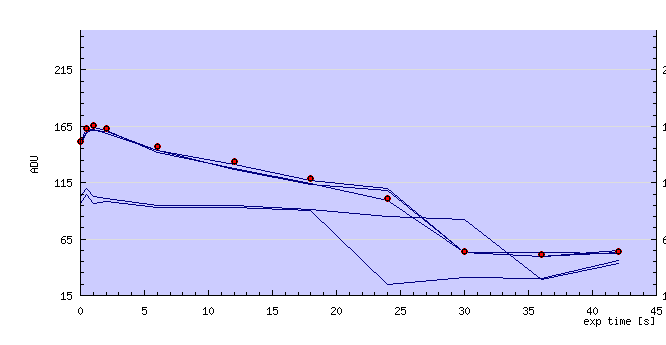
Dark level as a function of exposure time for the reset-read-read mode. The darks are taken in the following order (of integration times): 0.5, 42, 2, 30, 12, 18, 24, 36, and 1 seconds. They are multiples of 5 (using mdark t 5) to avoid spurious jumps, and they are taken just before domeflat exposures of the same integration time. Before each multiple dark is started, the array is cleared twice.
Vertical gradients and jumpsEach quadrant is readout line by line starting in the lower right corner (on the stored image, where an X-flip is introduced by NOT2MEF). All quadrants are read out simultaneously. A vertical gradient from first to last readout line in each quadrant, usually referred to as the "dc-gradient" and believed to be due to the reset anomaly, is an expected feature of this type of arrays. For reference see for instance the description of NICS/TNG darks.While vertical jumps at Y = 1 and Y = 512 are expected, quite particular for NOTCam darks, however, are the additional horizontal stripes and/or vertical jumps. For each of the 3 arrays used with NOTCam these jumps were located at different Y positions, as can be seen in the figure below.
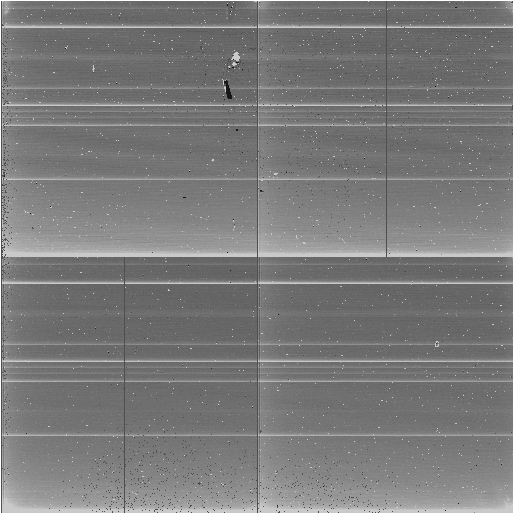
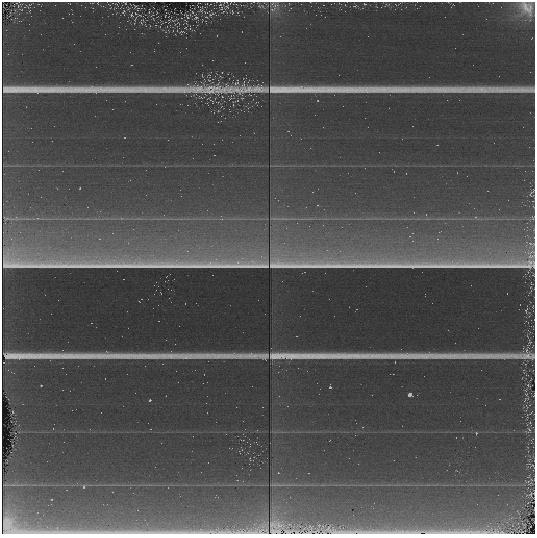
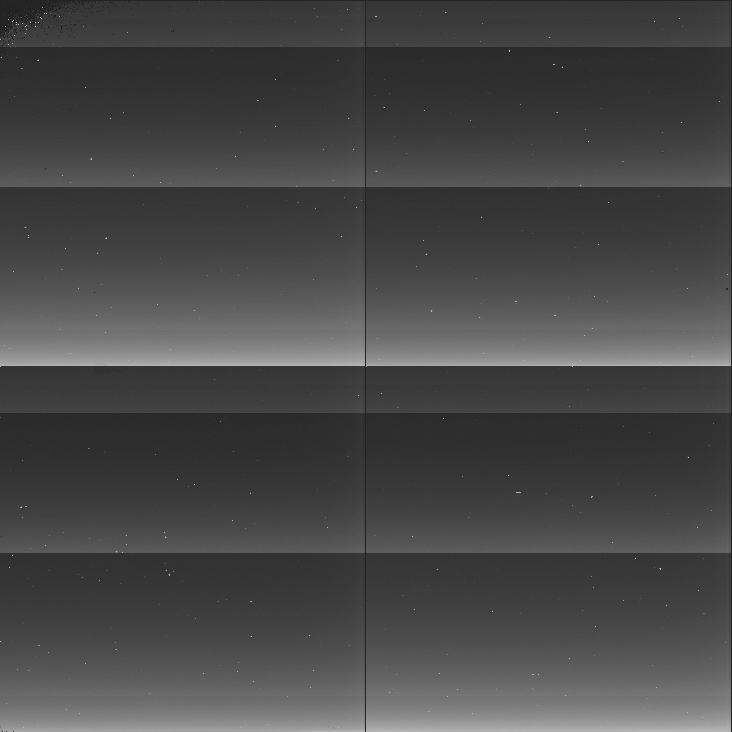
Zero darks (dark 0) obtained with the three arrays: SWIR1 (left), SWIR2 (middle), and SWIR3 (right). For SWIR1 both the gradient and the jumps were smaller before upgrading the array electronics with a new PCB, as shown in the document NOTCam Array Electronics upgrade Dec 2007. For SWIR3 there are jumps at lines Y = 51, 252, 447, and 486 in each quadrant, of which the first and the last are the ones with least difference in level on zero darks, and the y = 252 is the worst with a very heavy jump. The location of these jumps does not change with time. Depending on the contrast, the y=51 and 486 jumps may sometimes be hard to note on zero darks but stand out more clearly on longer darks.

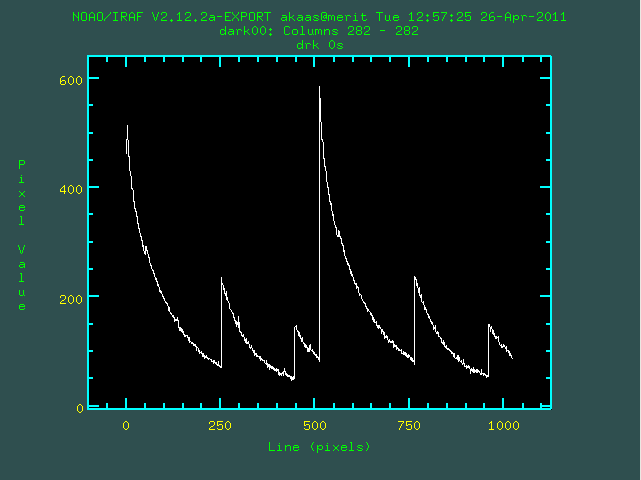
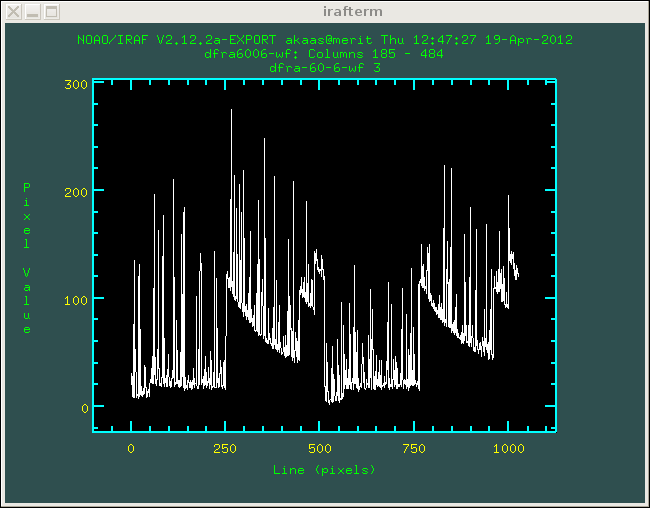
The SWIR1 (left) and SWIR3 (middle) vertical gradient(s) on zero darks. The SWIR3 veritcal gradient on 360s dark is shown to the right. The 4 jumps in each quadrant define 5 bands with different dark levels. This is not so clear from the short darks, but it is easy to distinguish 5 bands per quadrant from the longer darks (see graph to the right above and images shown below). These bands usually subtract out well, but occasionally they don't, and remains of this banding is left in the science images. As can be seen in the above graphs of the vertical cuts across darks, the gradient seen in short darks changes completely for longer darks. In fact, for longer darks the countlevel is lower all over, and for the first half of each quadrant (i.e. the two lower of the 5 "bands") count levels are now lower than the rest of the quadrant rather than higher. This turnover effect between short and long darks takes place at integration times between 30 and 40 seconds. Darks of integration times less than about 30 seconds behave as the zero darks.
Temporal variation of the dark levelSudden spikes in the dark level have also been seen. As an example, the dark level was roughly constant at 80-100 ADU for a number of darks with exptimes between 0.2 and 10 seconds and then suddenly jumped to 260 ADU for one 0.8 sec exposure. This behaviour is of intermittent nature.
Negative darksAs shown above, the count level gets lower the longer the integration time, suggesting it is not real dark current we are measuring. But what is it? For longer darks it is also clear that the dc-gradient seen on zero-darks goes the other way around, i.e. lowest counts in the beginning of readout and higher counts towards the end.When taking darks with the dark, mdark commands, having integration tims as long as 60 seconds or more, it is frequently found that the count level on part of the detector may become so low that it goes negative. Any NOTCam image is the difference between the post-read and pre-read images, of which the pre-read image, also called reset image, has a "bias" level of ~ 5500 adu. The subtraction is done before the image is stored, and because the images are stored as unsigned integers, negative pixel values wrap around to 65536 adu + pixel value and give rise to crappy-looking images of the type seen below that may mislead you to think you have saturated pixels.
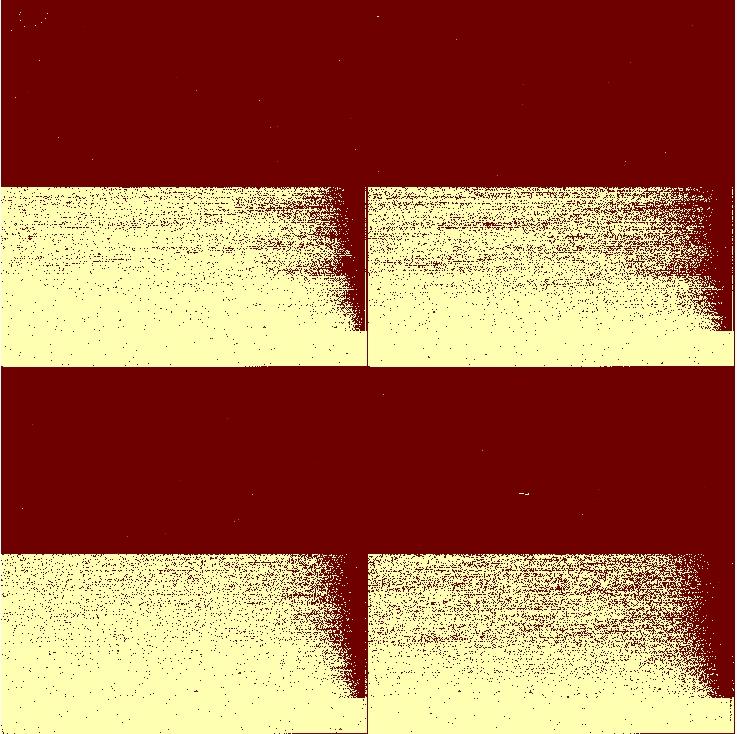
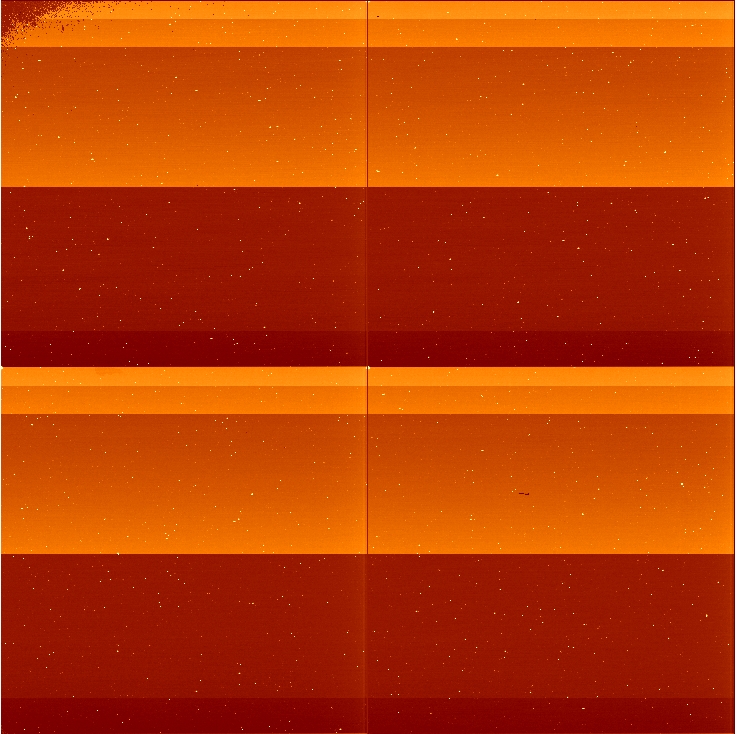
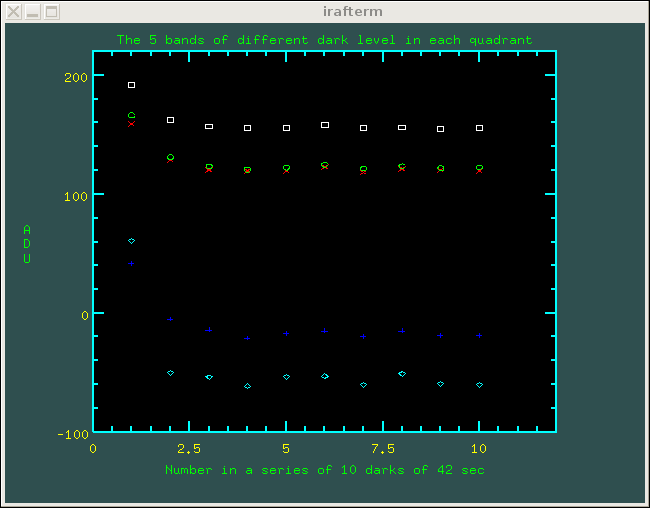
Left: A "dark 60" image suddenly shows up with lots of pixels at values > 60000 adu. These are negative pixels wrapped around because images are stored as unsigned integers. Middle: The same image "re-wrapped". Right: The adu level in the 5 bands (per quadrant) for a sequence of 10 darks of 42s.
Strange HR-cam darks in 2010In Sep 2010 it was discovered that if darks were taken with the instrument set up for the HR camera, the darks looked different. This had not been seen before. The determining factor was found to be the position of the detector with respect to the camera lens housing, i.e. the internal focus value.
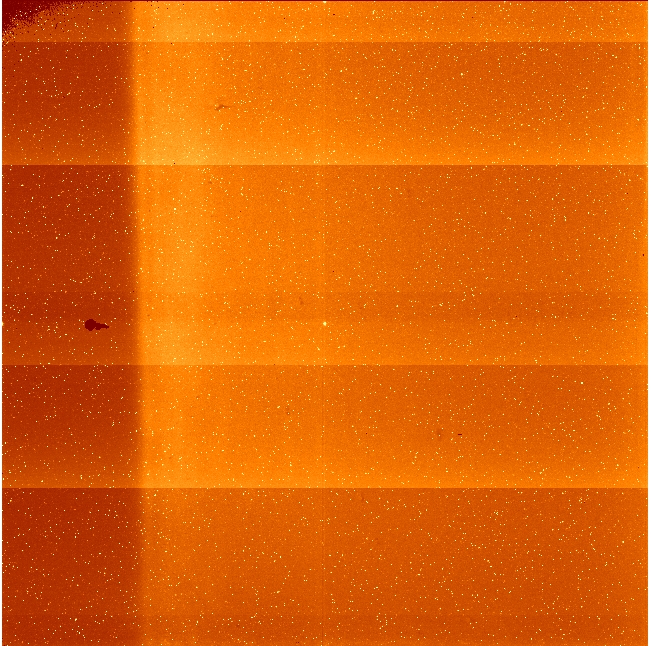

360 second long darks using "dframe 60 6" taken with the internal focus value at 20 (left) and internal focus value at 5650 (right). The left corresponds to the detector plate being at the furthest distance from the camera wheel. This is the focus value used for HR-camera imaging.
Long darks with the internal focus value set to 20 were taken repeatedly and on various occasions during October 2010 to investigate the cause of the problem which was found to persist.
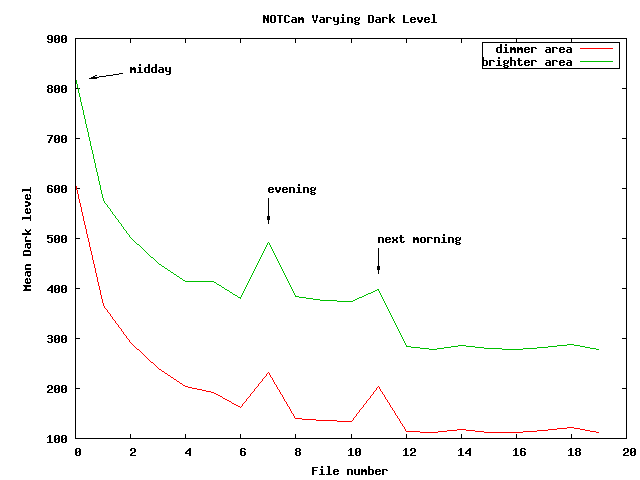 Several sequences of 360s long darks using "dframe 60 6" with the internal focus setting at 20. The first 4 darks are taken with NOTCam in normal mode. Then follows 3 darks with the focus motor disconnected, yet another 4 darks in the evening and 3 darks the next morning with the same setting. Then 3 darks with the focus motor reconnected and finally 3 darks after moving the focus mechanism to 5650 and back to 20. Whether the focus motor is connected or not, has no influence on the dark level, and heat from the motor is therefore exluded. The excess dark current at the left edge of the array points geometrically to the focus mechanism, partly shielded by the camera housing. As the above figure shows, however, the absolute level varies, but the relative difference between the bright and the dark region, i.e. the vertical structure seen in the upper left image, remains stable. There seems to be no relation between dark level and whether the focus mechanism is powered or not. At the next NOTCam opening possibilities of shielding the focus mechanism were looked at, but it was realized that there is no room to mount anything. Subsequent monitoring of long darks at the same focus position after the NOTCam opening in January 2011 found that the above behaviour simply had disappeared! Long darks are taken every now and then with the focus value at 20, but has not been seen to reoccur.
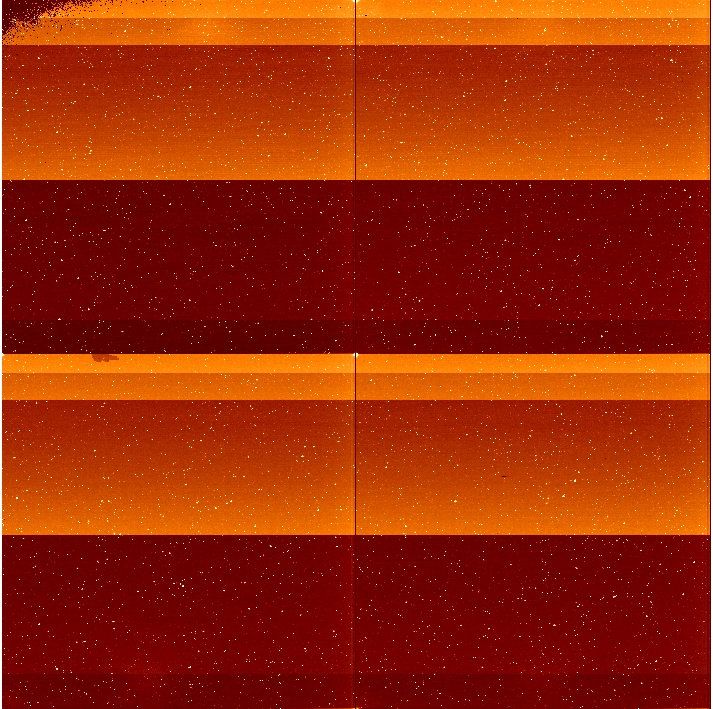
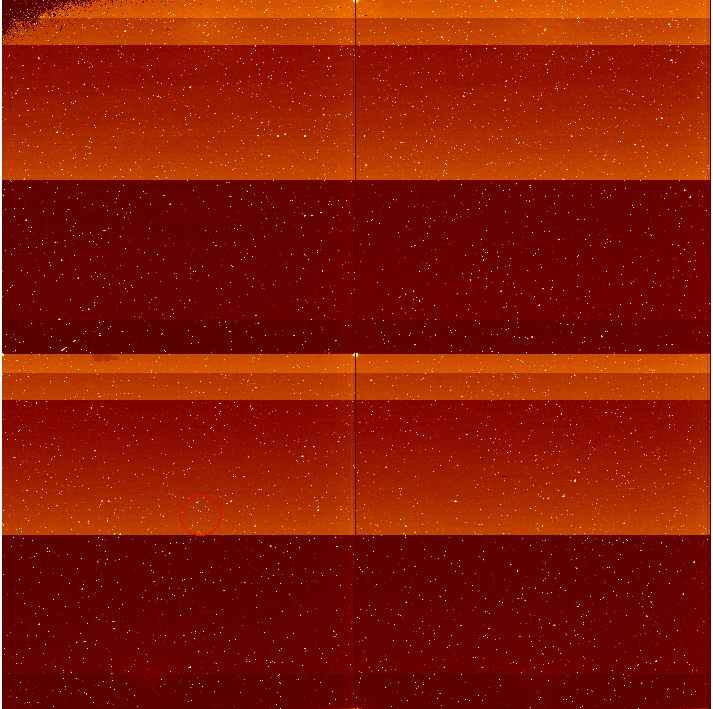
New data from April 2011 where the structure has disappeared. Again, these are 360 second long darks using "dframe 60 6" taken with the internal focus value at 20 (left) and internal focus value at 5650 (right). The levels are practically the same.
|